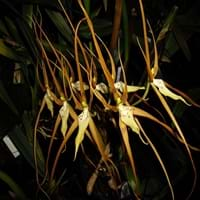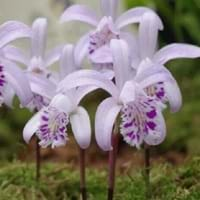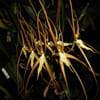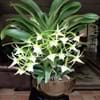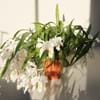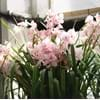Life Span
Annual
Perennial
Origin
Central America
China, India, Nepal
Types
Brassia allenii, Brassia caudata, Brassia cochleata
Pleione chunii , Pleione limprichtii
Habitat
Coastal Regions
Hilly upland habitat, Wooded hillsides
USDA Hardiness Zone
11-15
13-15
Sunset Zone
H2
Not Available
Habit
Clump-Forming
Clump-Forming
Flower Color
Light Yellow, Yellow green, Gold, Plum, Sienna
White, Yellow, Yellow green, Brown
Flower Color Modifier
Multi-Color
Bicolor
Fruit Color
Brown, Light Green
Non Fruiting Plant
Leaf Color in Spring
Green
Light Green
Leaf Color in Summer
Green
Light Green, Yellow green
Leaf Color in Fall
Green
Light Green
Leaf Color in Winter
Green
Not Available
Leaf Shape
Needle like
Elliptic to oblong
Plant Season
Summer, Fall
Spring, Winter
Sunlight
Partial Sun, Partial shade
Partial shade, Full Shade
Type of Soil
Not Available
Not Available
The pH of Soil
Not Available
Not Available
Soil Drainage
Well drained
Well drained
Bloom Time
Early Fall, Fall, Late Fall, Early Winter
Early Spring, Winter, Late Winter
Tolerances
Not Available
Light Frost
Where to Plant?
Container, Ground, Pot
Ground, Pot
How to Plant?
Divison
Bulbs
Plant Maintenance
Medium
Medium
Watering Requirements
Needs very little water
Do not water excessively, Needs very little water
In Summer
Lots of watering
Lots of watering
In Spring
Moderate
Moderate
In Winter
Average Water
Average Water
Soil pH
Not Available
Not Available
Soil Type
Not Available
Not Available
Soil Drainage Capacity
Well drained
Well drained
Sun Exposure
Partial Sun, Partial shade
Partial shade, Full Shade
Pruning
No pruning needed
Prune if you want to improve plant shape, Remove damaged leaves, Remove dead branches, Remove dead leaves
Fertilizers
Occasional light liquid fertilizer
All-Purpose Liquid Fertilizer, Compost
Pests and Diseases
Red blotch
Free of serious pests and diseases
Plant Tolerance
Not Available
Light Frost
Flower Petal Number
Single
Single
Foliage Texture
Coarse
Medium
Foliage Sheen
Matte
Matte
Attracts
Not Available
Birds, Bumblebees, Butterflies, Hummingbirds, Not Available
Allergy
Not Available
Unknown
Aesthetic Uses
Showy Purposes
Bonsai, Showy Purposes
Beauty Benefits
Not Available
Not Available
Environmental Uses
Air purification
Air purification
Medicinal Uses
Not Available
No Medicinal Use
Part of Plant Used
Flowers, Fruits, Leaves
Not Available
Other Uses
Showy Purposes
Acts as a natural source of rain water for birds and insects., Beneficial species for attracting pollinators
Used As Indoor Plant
Yes
No
Used As Outdoor Plant
Yes
Yes
Garden Design
Container, Cutflower, Feature Plant, Hanging Basket, Houseplant, Tropical
Container, Hanging Basket, Houseplant, Tropical
Botanical Name
BRASSIA arcuigera
SIGMATOSTALIX amazonica
Common Name
Arching Brassia, Arching Spider Orchid, Orchid
Amazon Sigmatostalix Orchid, Miniature Orchid
In Hindi
Arching Brassia plant
miniature orchid
In German
Arching Brassia Pflanze
miniature orchid
In French
plante Arching Brassia
Pleione
In Spanish
planta de arqueo Brassia
Pleione
In Greek
φυτό κύρτωση Brassia
Pleione
In Portuguese
planta arqueamento Brassia
miniature orchid
In Polish
Wyginając Brassia roślin
miniature orchid
In Latin
Curva Brassia herba
miniature orchid
Phylum
Magnoliophyta
Magnoliophyta
Class
Liliopsida
Liliopsida
Order
Asparagales
Asparagales
Family
Orchidaceae
Orchidaceae
Clade
Angiosperms, Monocots
Angiosperms, Monocots
Tribe
Cymbidieae
Coelogyneae
Subfamily
Epidendroideae
Epidendroideae
Number of Species
Not Available
Not Available
Difference Between Arching Brassia and Miniature Orchid
If you are confused whether Arching Brassia or Miniature Orchid are same, here are some features about those plants to help you choose better. Many people think that these two plants have the same characteristics, but one can see Arching Brassia and Miniature Orchid Information and learn more about it. Fertilizers required for proper growth of Arching Brassia are Occasional light liquid fertilizer, whereas for Miniature Orchid fertilizers required are All-Purpose Liquid Fertilizer and Compost. Hence, one should know the basic difference between Arching Brassia and Miniature Orchid if you are planning to have them in your garden to enhance its beauty.
<
Flowering PlantsImportance of Arching Brassia and Miniature Orchid
Want to have the most appropriate plant for your garden? You might want to know the importance of Arching Brassia and Miniature Orchid. Basically, these two plants vary in many aspects. Compare Arching Brassia and Miniature Orchid as they differ in many characteristics such as their life, care, benefits, facts, etc. Every gardener must at least have the slightest clue about the plants he wants to plant in his garden. Compare their benefits, which differ in many ways like facts and uses. The medicinal use of Arching Brassia is Not Available whereas of Miniature Orchid is No Medicinal Use. Arching Brassia has beauty benefits as follows: Not Available while Miniature Orchid has beauty benefits as follows: Not Available.
Compare Facts of Arching Brassia vs Miniature Orchid
How to choose the best garden plant for your garden depending upon its facts? Here garden plant comparison will help you to solve this query. Compare the facts of Arching Brassia vs Miniature Orchid and know which one to choose. As garden plants have benefits and other uses, allergy is also a major drawback of plants for some people. Allergic reactions of Arching Brassia are Not Available whereas of Miniature Orchid have Unknown respectively. Having a fruit bearing plant in your garden can be a plus point of your garden. Arching Brassia has no showy fruits and Miniature Orchid has no showy fruits. Also Arching Brassia is flowering and Miniature Orchid is not flowering . You can compare Arching Brassia and Miniature Orchid facts and facts of other plants too.
